Do-No-Harm Design
APPLYING ADVANCES TO HEALTHCARE FACILITIES
Updating Restrooms to Reduce Risk
Fixture Strategies that Eliminate the Spread of Germs
When providing life-sustaining care to the patients at a facility, the building and its components can’t afford downtime. Every piece of equipment needs to meet the highest standards of quality and reliability. Faucets and fittings specially designed for the demands of the healthcare community must be able to meet the highest hygiene standards while also offering the highest level of safety for patients and staff.
Properly designed, a restroom minimizes hand contact with fixtures and is easy to clean. Older buildings with dated components might not meet current sanitary standards. However, advances in products and materials are allowing for easy adaptation or selection of fixtures to minimize hygiene concerns.
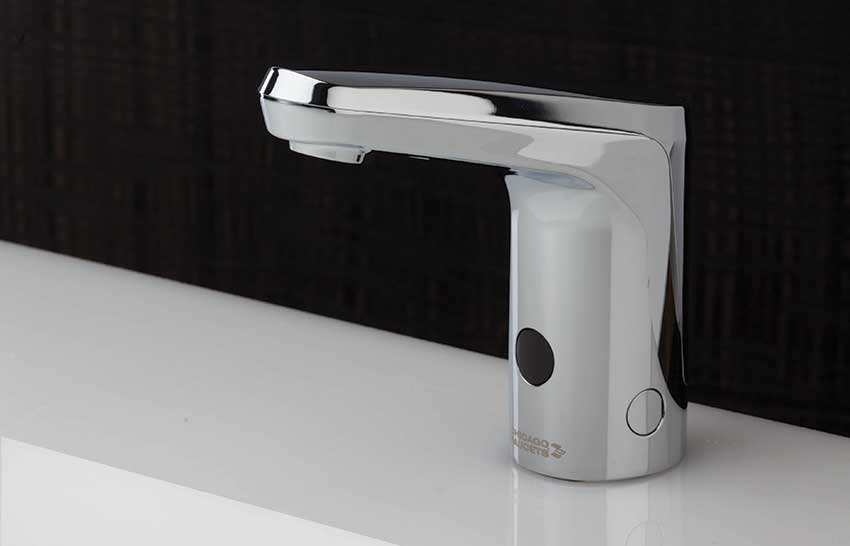
Photo courtesy of Chicago Faucets
Today’s touchless faucets are also durable and safe, and certain ranges of touchless faucets are also fully programmable, offering different operating modes for different environments. Touchless faucets with pre-set water temperatures and scald protection are ideal for ADA compliance.
Technology makes it possible for people to never touch a thing when using a restroom. From touch-free toilet flushing to throwing a used paper towel into the waste receptacle, visitors can enjoy an entirely hands-off restroom experience. Quick changes include soap dispensers equipped with motion sensors, which eliminate the need for touching a potentially germ-laden surface. Consider foam dispensers that use as little soap as possible to get hands clean. John Ross, MD, FIDSA, contributing editor of Harvard Health Publishing’s Harvard Health Blog, cites recent research demonstrating that paper towels are still the most hygienic way to dry hands. Touchless towel dispensers don’t have to be electronic. Some models simply dispense one towel at a time, which the user can release without touching the unit. After each towel is taken, a fresh towel is released for the next user.
Porous surfaces hold moisture, a perfect breeding ground for germs. As a moderate upgrade, consider replacing drywall and paint with ceramic tile or stainless steel, and vinyl flooring with tile. The American Restroom Association suggests using curved tiles in junctures between the floor and wall rather than butting flat tiles against the wall, eliminating the 90-degree angle where dirt and germs can collect.
Faucet handles are the greatest source of germs on any manual faucet. The CDC provides very thorough guidelines on handwashing to prevent the spread of germs and disease. The CDC suggests scrubbing hands with soap for at least 20 seconds.1 If a person touches the same handle to turn the faucet on and off, they risk contaminating their hands again. They may transfer germs back to their hands or pick up germs left by other patrons. Washing for 20 seconds won’t protect against recontamination.
Antimicrobial faucet handles are a good strategy to decrease the spread of germs resulting from contact with handles. The antimicrobial technology uses a coated surface to inhibit the growth of microorganisms on surfaces and is particularly effective at stopping fungal growth. The coating also lowers the porous nature of surfaces, keeping handles cleaner than those of typical faucets. Antimicrobial handles are practical and budget-friendly. Depending on manufacturer, components may be interchangeable, allowing for replacement of handles on manual faucets only, as opposed to buying and installing new faucets.
Additional technologies to ensure hygienic practices are metering faucets and scrub sinks. Metering faucets run for an amount of time programmed by the designer or facility manager. After that time, the faucet shuts off. Metering faucets lengthen the time people spend washing their hands. If water runs for 20 seconds or more, it encourages people to wash their hands for that amount of time. Signage near the faucets educates users in critical public safety roles that govern the settings on metered faucets.
In hospitals, scrub sinks can include metered faucets that are set to run for the amount of time appropriate to the hospital staff’s tasks. For instance, in surgical areas, water can run for longer periods. These periods can be set to match mandatory scrubbing requirements. Scrub sinks with metered run-times make managing scrub time simple. Hospital staff won’t need to count, sing songs, or watch clocks to measure scrubbing time. Metered faucets also offer water-saving benefits. Facility managers determine how long they are on or choose from predetermined settings. They encourage efficient use. Metered faucets shut off automatically, making it impossible for a user to walk away and leave the faucet running for hours at a time.
Touchless faucets overcome the hygiene challenges of faucet handles by eliminating physical interaction for operation. A no-touch faucet prevents users from leaving behind and picking up germs on faucet handles. Advanced sensing controls allow touchless faucets to operate the way users expect, with no run-ons or ghosting. Today’s touchless faucets are also durable and safe, and certain ranges of touchless faucets are also fully programmable, offering different operating modes for different environments. Touchless faucets with preset water temperatures and scald protection are ideal for ADA compliance. Users do not have to manipulate any handles or controls to wash their hands.
Fixture Strategies That Protect Users
A healthcare facility without anti-scald faucets and valves places members of the community at risk of first, second, and even third-degree burns. Children, the elderly, and those with certain disabilities are the most vulnerable to getting burned by water that is too hot. Approximately 20% of all burn injuries are from scalding incidents, and nearly 75% of scalding cases in children are preventable (John Hopkins Medical).
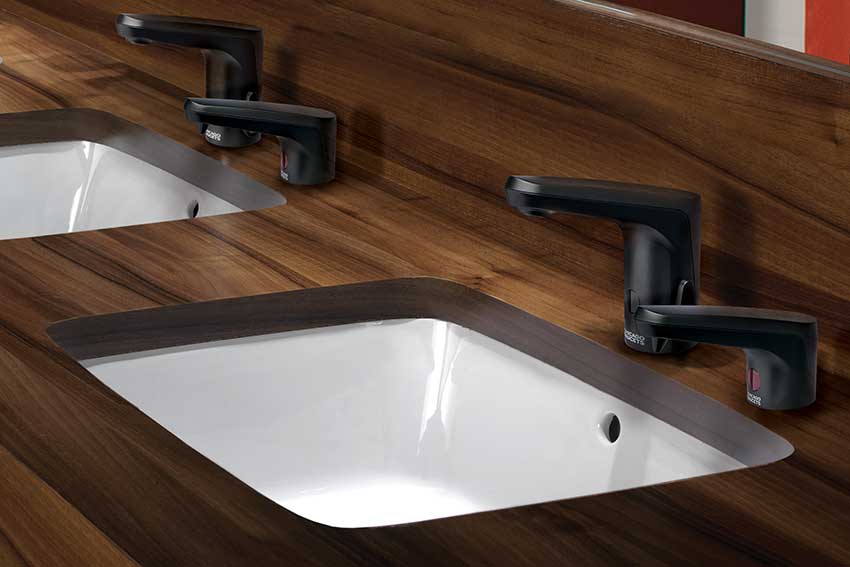
Photo courtesy of Chicago Faucets
Scald protection and temperature controls shield the most vulnerable users from scalding, providing safety and peace of mind.
Bacteria can grow in water with temperatures below 120ºF. That can leave water unsafe for use. When water heaters are at 140ºF, the water inside the tank is free from harmful bacteria. However, water at that temperature can lead to second or third-degree burns with less than five minutes of exposure. Water at 155ºF will burn within one second of contact, and at 160ºF can scald a person in under half a second of contact with skin. Installing scald protection products in healthcare buildings will not only improve public safety, but also will ensure that the facility remains compliant with federal, state, and local mandates. Anti-scald faucets and valves are devices within plumbing fixtures that prevent water from getting too hot. Federal, state, and local municipalities typically mandate these devices according to building codes to help keep the public safe by preventing painful burn injuries. There are three types of anti-scald devices, including thermostatic mixing (Type T), pressure-balanced (Type P), and combination fittings (Type T/P).
- Thermostatic Mixing (Type T): Type T faucets and valves have a thermostatic element inside of the unit. The building manager or service technician never needs to recalibrate the fixture, even if the temperature on the building's water heater is changed. These fixtures and fittings are somewhat more expensive than Type P models. However, Type T devices are worth the added expense because these faucets and valves accommodate a higher water heater temperature setting. This ensures that the water is hot enough to kill bacteria that could be in the water supplies.
- Pressure-Balanced (Type P): This type is the least expensive of the anti-scald models available. It allows control of water pressure using a piston or diaphragm inside the fixture. These components move in reaction to changes in water pressure. These protection devices balance the pressure between cold and hot water flows and are generally not expensive. The device senses when someone is using insufficient amounts of cold water, risking scalding, and adjusts as the water temperature changes. It does this by limiting the amount of hot water that can move through the chamber of the fixture. One downside of a Type P is that it must be recalibrated if the water heater’s temperature is changed.
- Combination (Type T/P): When installing a Type T/P anti-scald fitting, the benefits of both technologies are captured. The pistons within the fixture balance water pressure while the thermostatic element reacts to the temperature of the water. These devices are more durable, capable of withstanding the wear and tear of high-traffic facilities.
Advancements in fixtures for healthcare facilities allow manufacturers to craft durable, commercial-grade faucets, fixtures, and fittings that not only withstand the abuse of heavy use but also offer safety features like anti-scald and touchless technology, keeping everyone who visits, works at, or lives in the facilities safe.
Using Ceiling Tiles from Natural Materials to Deliver Performance
Achieving Acoustic Control
Just as the air occupants breathe surrounds and affects them, so, too, do the sounds they hear. Hearing is the only sense that cannot be voluntarily shut off, even during sleep. Sound control therefore becomes a critical issue, particularly in a high-volume healthcare clinic. Loud and overlapping sounds, even at a conversational level, quickly become unwanted noise. Noise can cause distraction, confusion, agitation and can interfere with sleep. It can mean that a healthcare professional loses focus and inaccurately records critical information. It can mean that a nurse becomes desensitized to auditory monitoring alarms and is slow to react to a patient in need. It can mean that a patient with compromised hearing does not understand a doctor’s instructions. It can also mean that a private conversation between a family and a medical professional is overheard, violating HIPAA rules.
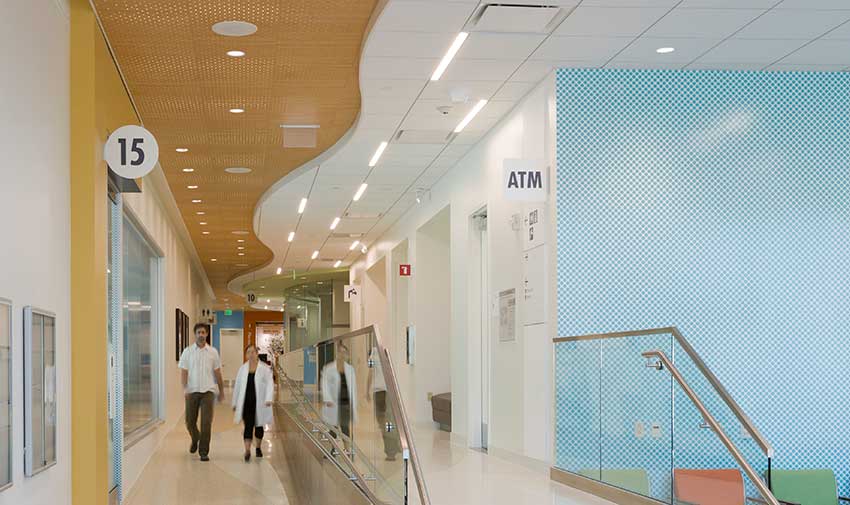
Photo courtesy of mocphoto, Michael O'Callahan; Rockfon
A product's inherent qualities should also be durable, allowing for longevity and sustainability of the structure. Permanente Mission Bay Medical Offices, San Francisco.
Notice
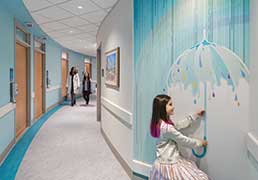
www.inpro.com
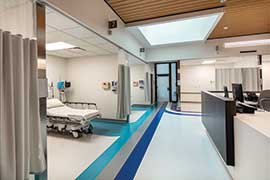
www.rockfon.com
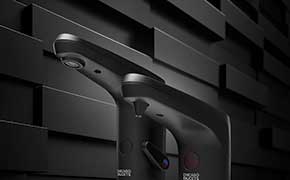
www.chicagofaucets.com









